While this article is about a great way to spend a day in Hiroshima, it is just one in a series of articles about other amazing destinations you can discover using Hiroshima as your home base. Using the convenient and inexpensive Hiroshima bus network, you’ll be able to travel around this beautiful region on a shoestring budget.
Once, in my late teens, I took the bus from San Francisco to… somewhere. In truth, I no longer remember what my destination was, partly because the decades steal away details like that, but mostly because I don’t care to remember. Riding the bus in urban America is an eye-opening experience to something you’d rather not have your eyes opened up to. That is why I say, once I took the bus from San Francisco. Only once.
When I moved to Japan, my opinions about public transportation were turned upside-down. Who comes to Japan and doesn’t dream of riding the Shinkansen? Who doesn’t secretly delight in catching a taxi, where the white-gloved driver doesn’t even require you to touch the door handles? But buses, well, buses I hardly knew, until one day, to save money, I took an overnight bus to Sendai instead of the usual bullet train. I realized that buses in Japan, like all other forms of public transportation, are worlds apart from the horrors I experienced that day in San Francisco.
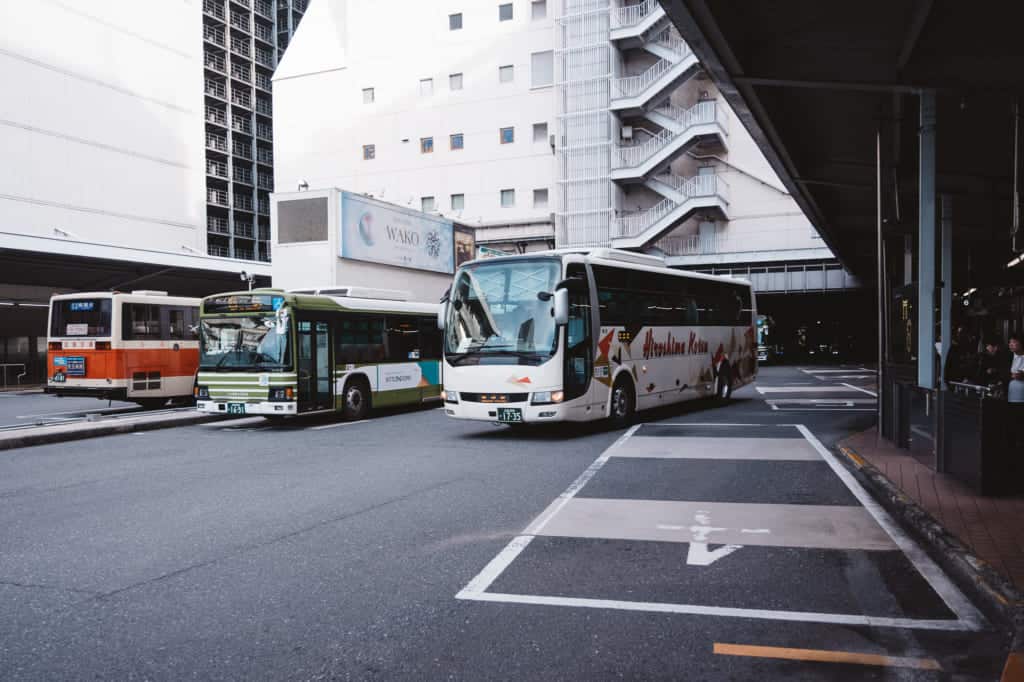
I tell you this because I realize many of you may have the same opinion of bus service that I did before coming to Japan. You may turn up your nose at this form of transportation as the one used only as a last resort. In this series of articles, however, I’m going to take you with me on a six-day adventure around Japan’s Chugoku region, specifically Hiroshima, Shimane and Tottori prefectures, mostly by bus. And at the end of it all, you will find, as I did, that bus travel is not only comfortable and convenient in this part of Japan, but it can save you a lot of money.
But today, we’re going to start at “home base,” Hiroshima city. We won’t ride any buses today; however, we will be catching one early tomorrow morning, so I already stopped by the Hiroshima Bus Terminal and picked up the money-saving “Visit Hiroshima Tourist Pass.” This pass enables me to ride city streetcars and most buses within Hiroshima Prefecture as much as I want for 3 or 4 days, depending on the pass. To familiarize yourself with the Hiroshima Bus Terminal, please read my article with tips on how to use it to save you a lot of money in transportation.
Hiroshima’s Tragic History and Rebirth as “City of Peace”
It goes without saying that one of history’s greatest tragedies occurred in Hiroshima on August 6th, 1945, when America dropped the first of two atomic bombs on Japan. Over 70,000 people were killed instantly; estimates put the total number of casualties by radiation and explosion at 135,000. A visit to the Hiroshima Peace Park and Peace Memorial Museum is a must-do for most visitors, though the experience can leave you shaken.
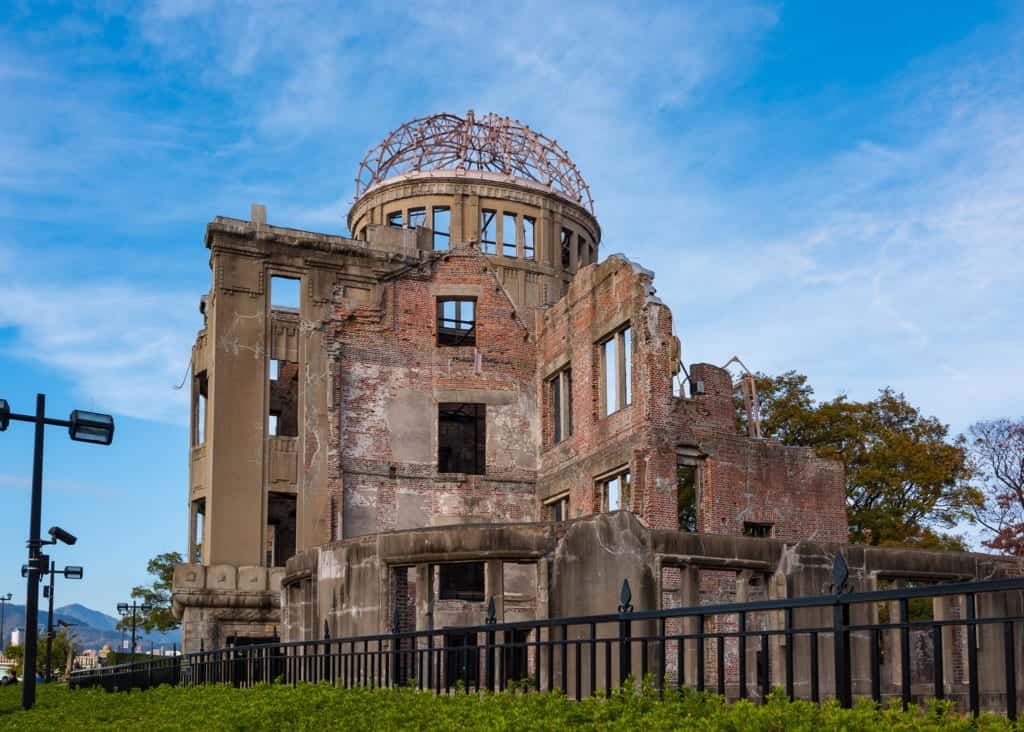
Hiroshima was rebuilt relatively quickly after the war, with significant funding coming from a law passed in 1949, providing finances and land for rebuilding projects. Today, Hiroshima is home to over 1 million people, a championship baseball team (Hiroshima Carp), and is becoming a fast-growing tourist destination. It is known as the “City of Peace” and has led the charge to rid the world of nuclear weapons.
Initially, it was the Peace Memorial Museum that brought my family and me here in 2017, but during our brief stay, we learned there was much more to see and do in this fascinating city. So invited back for a six-day tour of the area, I was gleeful stepping off the Shinkansen onto the platform at Hiroshima Station.
My traveling companions for the tour, the consummate professional translator and tour guide Hiro-san, and the tall, always-smiling Sugano-san from the Chugoku District Transport Bureau, greeted me at the station. After a long train ride, I arrived a bit hungry, and what better introduction to the city of Hiroshima than its most famous food, okonomiyaki?
 Peace Memorial Park - Hiroshima
Peace Memorial Park - Hiroshima
TOURIST ATTRACTION- Nakajimacho, Naka Ward, Hiroshima, 730-0811, Japan
- ★★★★☆
 Hiroshima Peace Memorial Museum
Hiroshima Peace Memorial Museum
TOURIST ATTRACTION- 1-2 Nakajimacho, Naka Ward, Hiroshima, 730-0811, Japan
- ★★★★☆
Why Hiroshima-style is the Best Okonomiyaki
Okonomiyaki is central Japan soul food, a savory combination of wheat-based batter, cabbage, and egg, combined with an endless variety of you name it: seafood, cheese, green onion, even mochi. The “okonomi” in okonomiyaki means “as you like it,” so most restaurants have extensive menus of okonomiyaki variations or simply allow the customer to customize it to their liking.
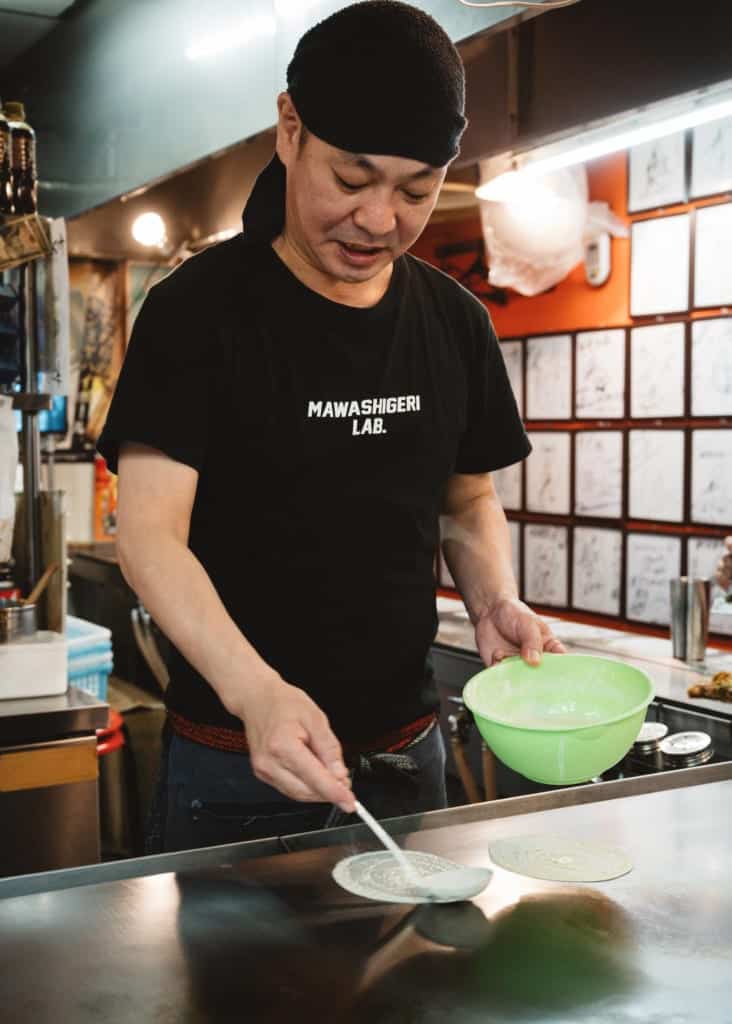
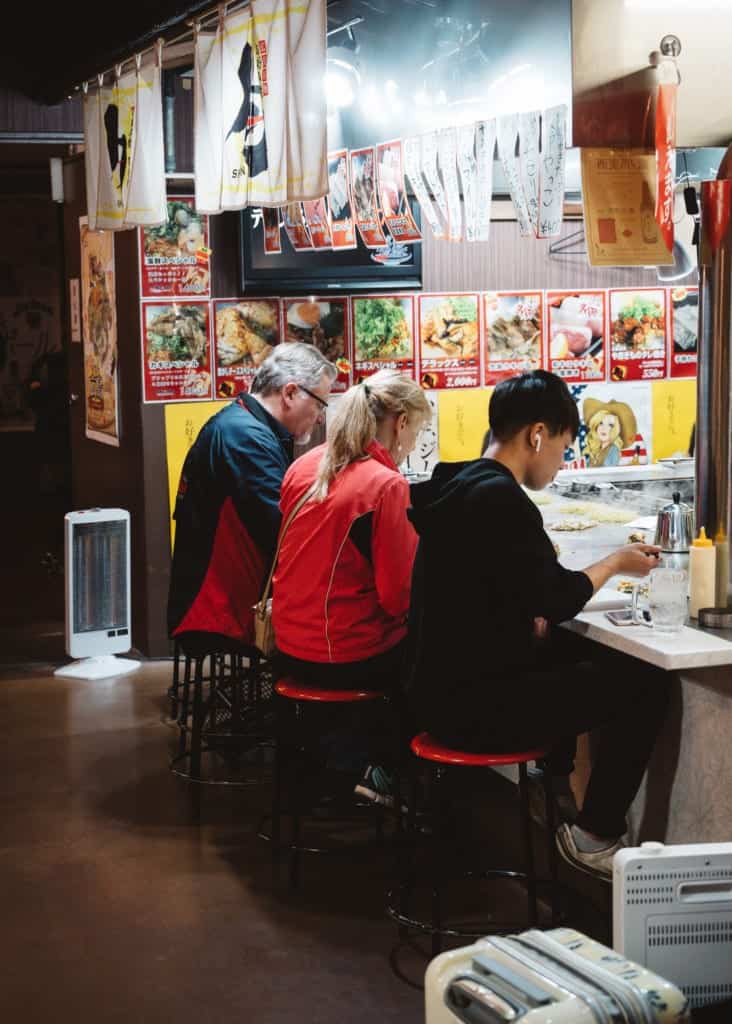
Land wars are rumored to have broken out over which city makes the best style okonomiyaki, Osaka or Hiroshima. With all due respect to my Osaka friends, my opinion is Hiroshima wins it hands-down. And that gooey mess Tokyoites call monjayaki? It doesn’t even place.
Hiroshima-style okonomiyaki is a much lighter version of Osaka’s, like comparing a Brittany crepe to an IHOP pancake. It is loaded with cabbage but layered in with thin layers of batter, noodles, grilled pork, and a fried egg. Further proof that Hiroshima-style is the more elegant dish is that most Osaka-style restaurants bring you the ingredients and let you cook it yourself on a grill at your table, like a caveman. Hiroshima-style is best left to the professionals.
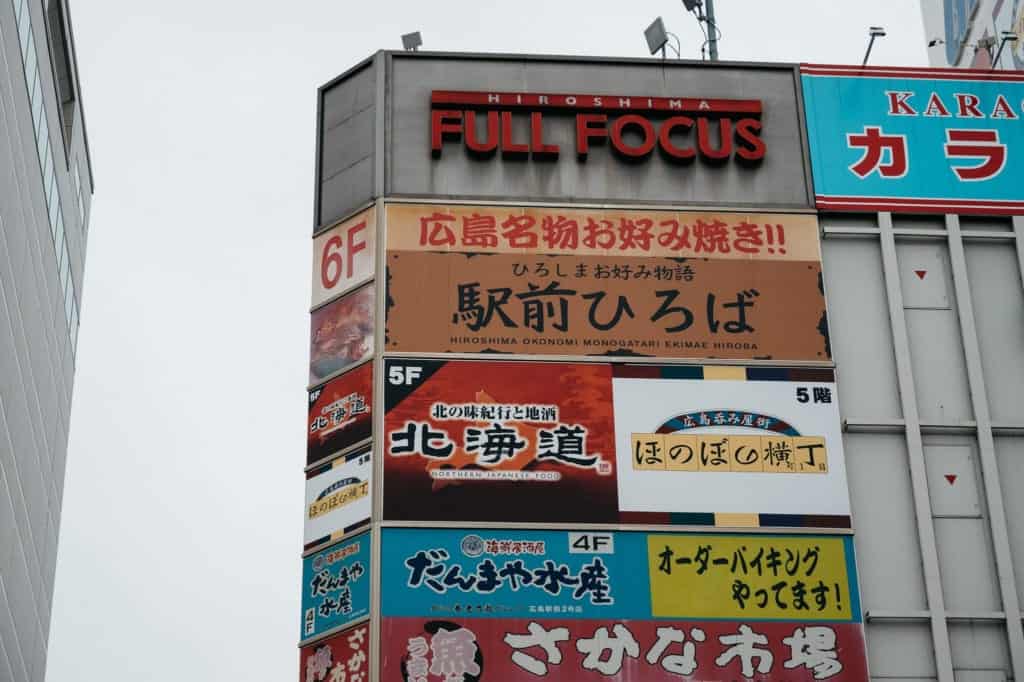
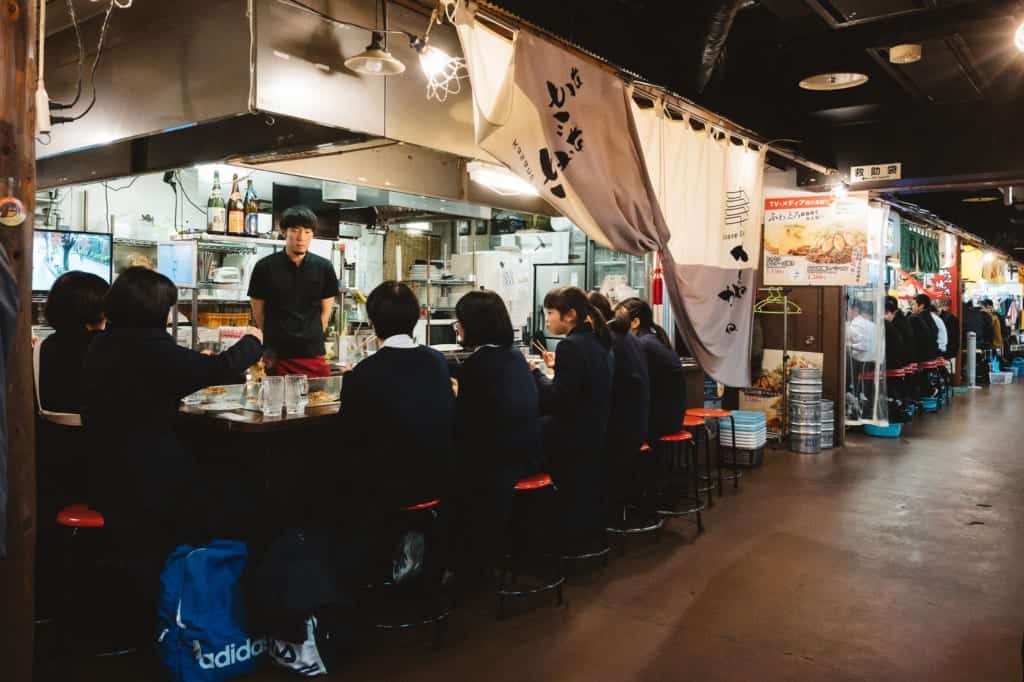
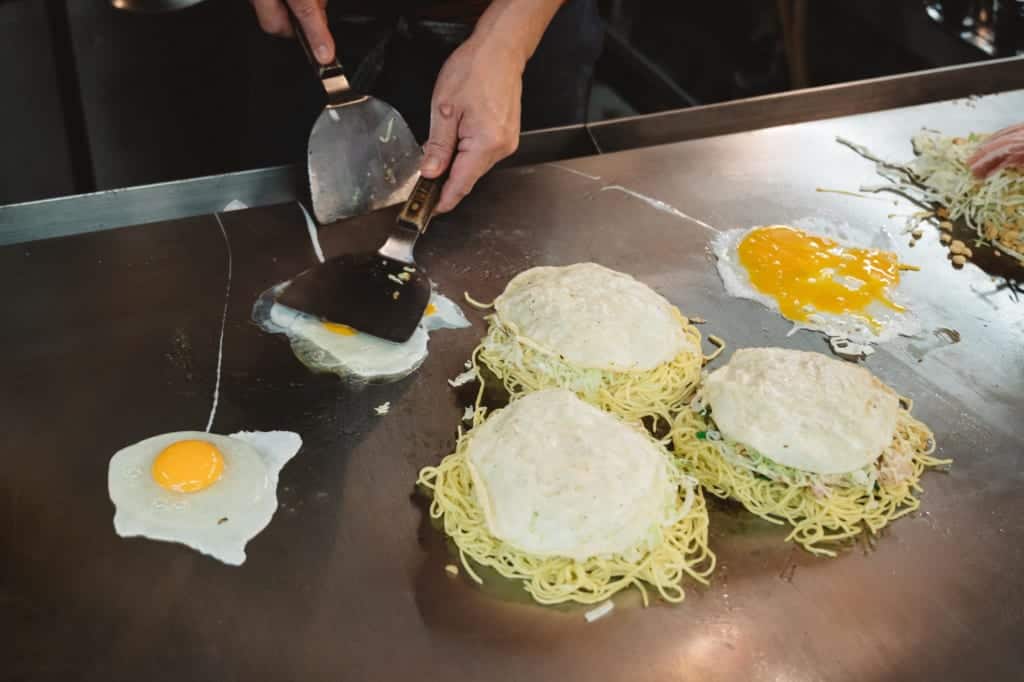
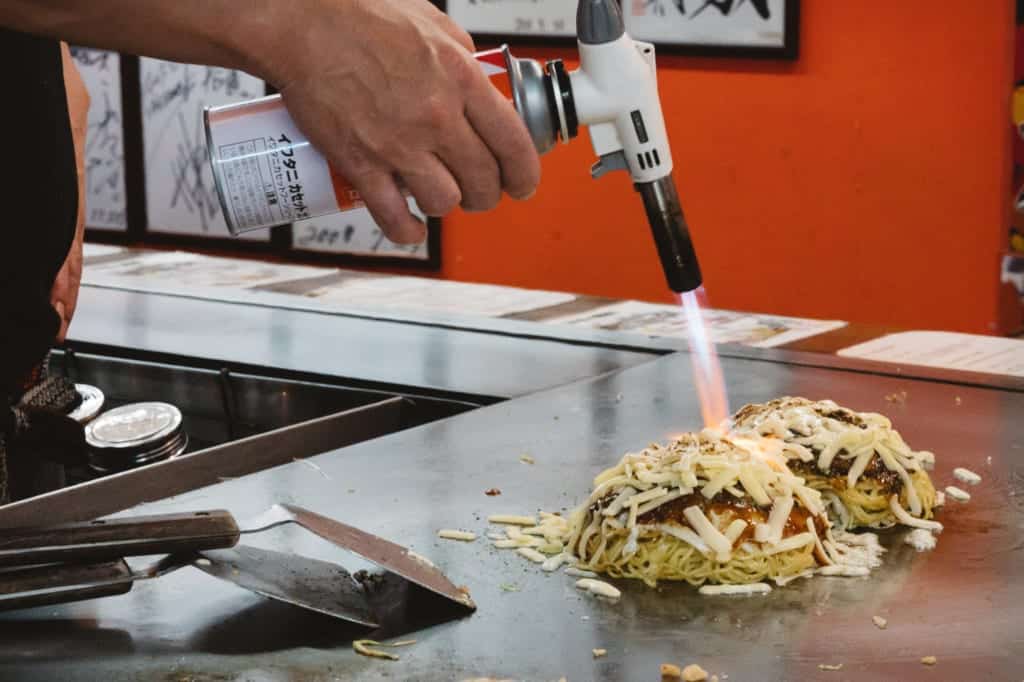
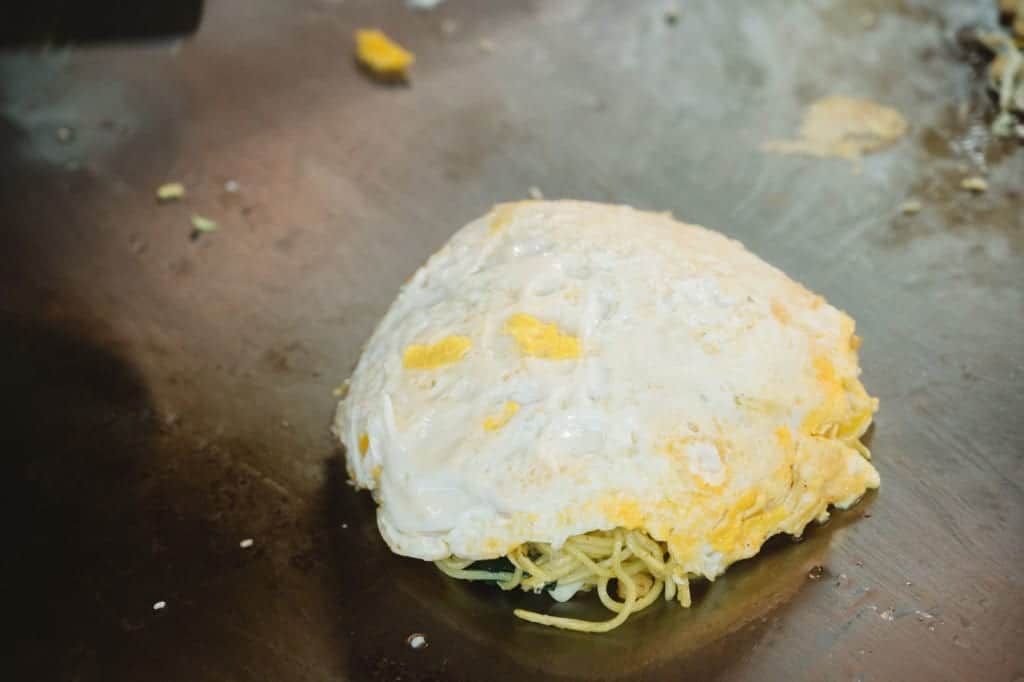
That is unless you are Sugano-san, who is a self-professed Hiroshima okonomiyaki legend in his own home. The accommodating chefs at Sozo let Sugano-san behind their counter for a little friendly competition. Sozo’s claim to fame is their hand-pulled soba noodles and a secret sauce, which you can buy in a bottle if you want to make Sozo-style okonomiyaki at home. They have a large variety of options here, including gluten-free and vegetarian.
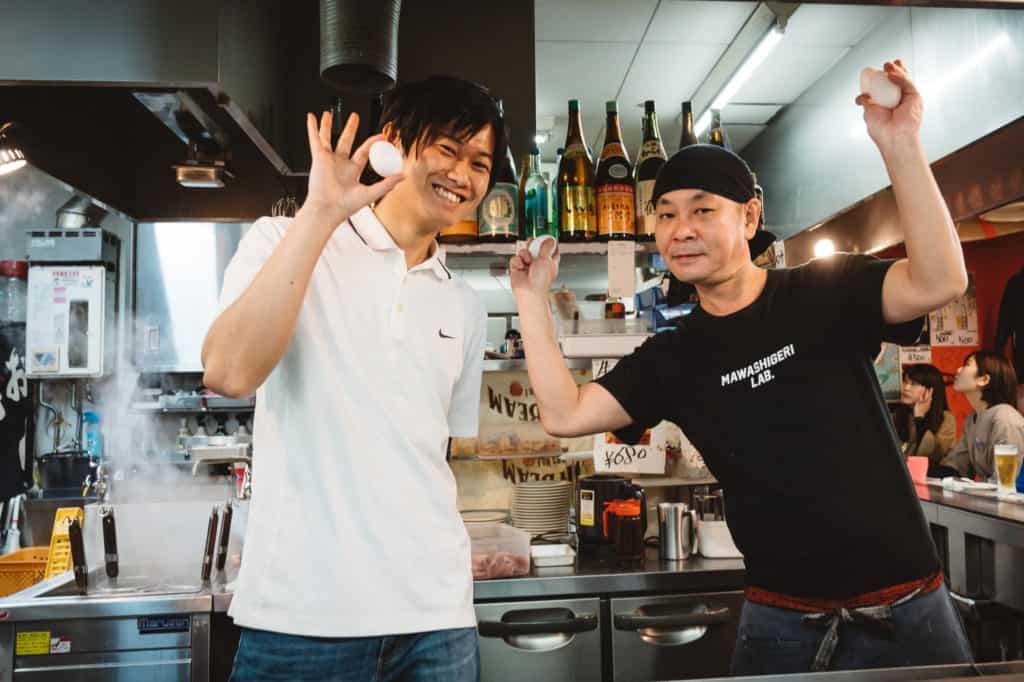
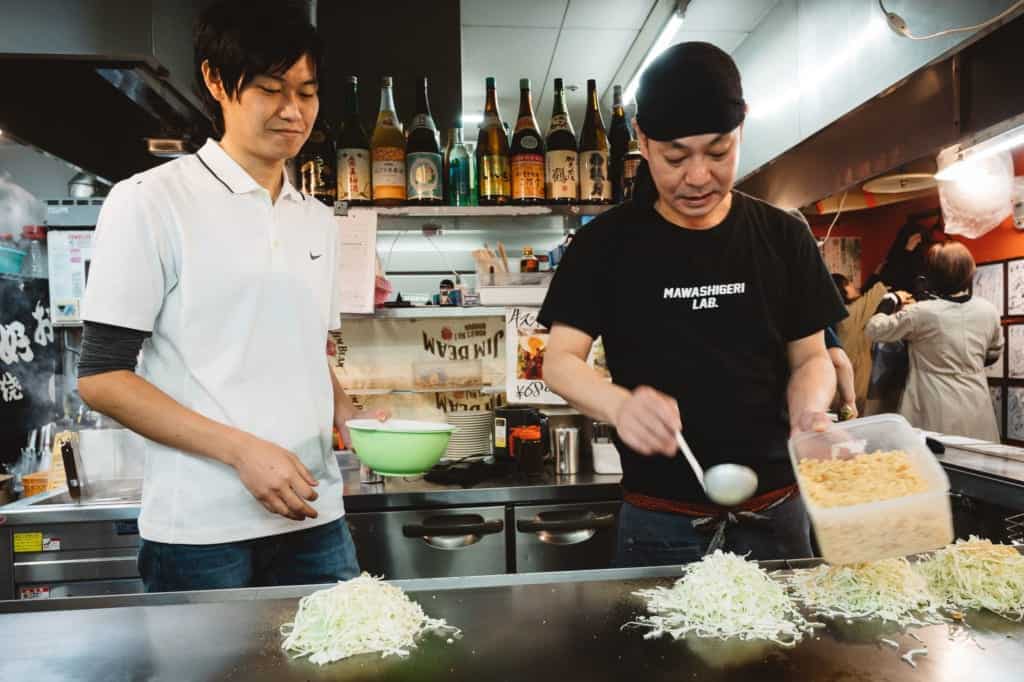
So who was the winner? Since Sugano-san quickly consumed his creation by himself, I guess we’ll never know. All I know is the chef at Sozo prepared my okonomiyaki with the precision of a moon landing, and the dab of daikon oroshi (grated Japanese radish) with a dash of special sauce on top was an unexpected flavor bomb.
 Sozo
Sozo
RESTAURANT- Japan, 〒732-0822 Hiroshima, Minami Ward, Matsubaracho, 10−1 広島フルフォーカスビル 6F
- ★★★☆☆
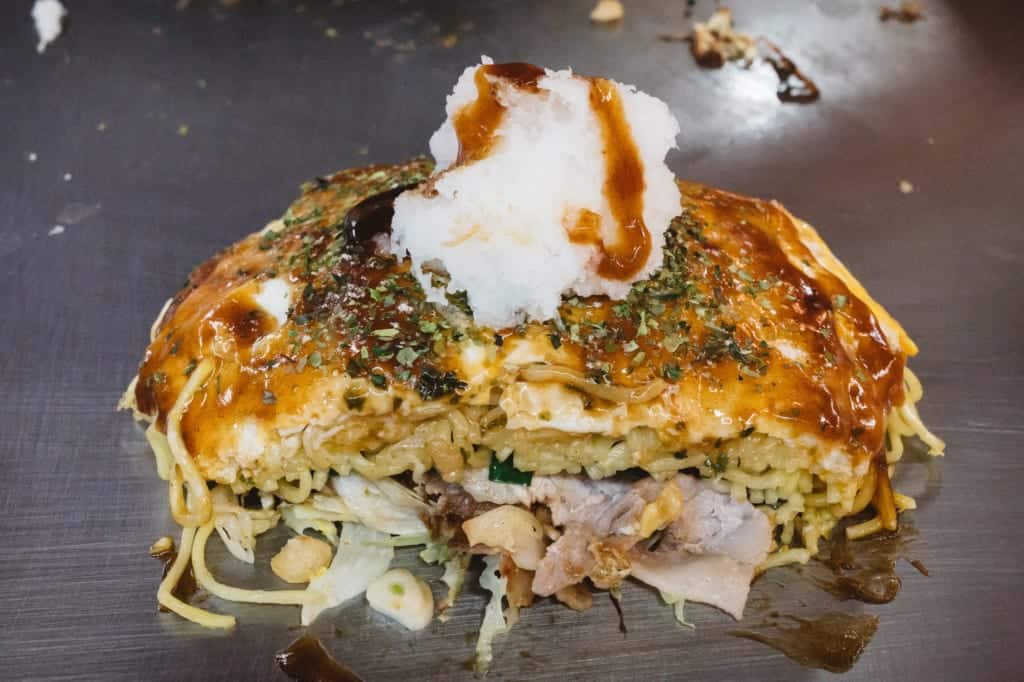
Sozo is part of the Hiroshima Okonomi Monogatari Ekimae Hiroba, which is an enormously difficult name for a collection of okonomiyaki shops on the 6th floor of the building across from JR Hiroshima Station. The place gets rockin’ in the evenings for dinnertime, but customer turnover is quick, so you should be able to get a seat at one of the counters without a long wait.
Orizuru Tower
Our next destination is the recently renovated Hiroshima Orizuru Tower, which stands 13 stories tall, including the observation deck, opposite the Atomic Bomb Dome. As luck would have it, Pope Francis was visiting Hiroshima the same day I arrived, and he would be speaking to a small crowd in the Peace Park briefly in the evening. While it was a special occasion for the city of Hiroshima, it also meant that visitors were not allowed in the park until after 8:00 pm that evening. So instead, we decided to enjoy the view of the park from the observation deck of the tower and visit the park and museum later.
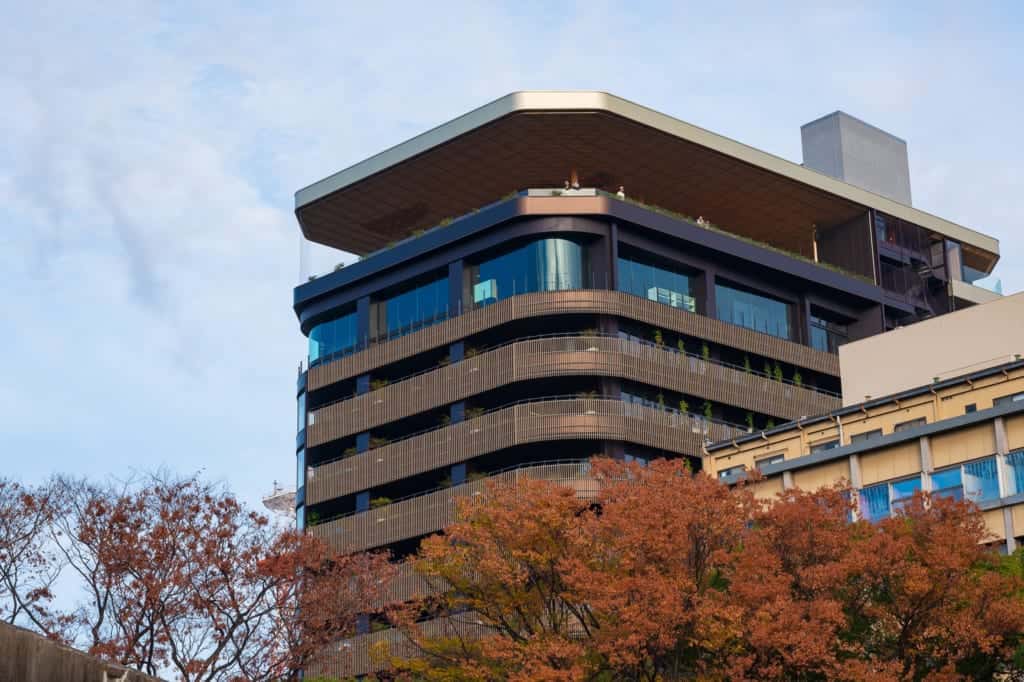
The observation deck of Orizuru Tower, called Hiroshima Hills, is unlike anything you’ve seen before. The name is derived from the gentle slope of the floor, so those sitting away from the edges of the deck have a clear view over the heads of those below them. Today was cloudy and crisp; the warm glow of the setting sun fell on the nearby mountains and islands, as well as on the fall foliage of the Peace Park below.
 Hiroshima Orizuru Tower
Hiroshima Orizuru Tower
TOURIST ATTRACTION- 1 Chome-2-1 Otemachi, Naka Ward, Hiroshima, 730-0051, Japan
- ★★★★☆
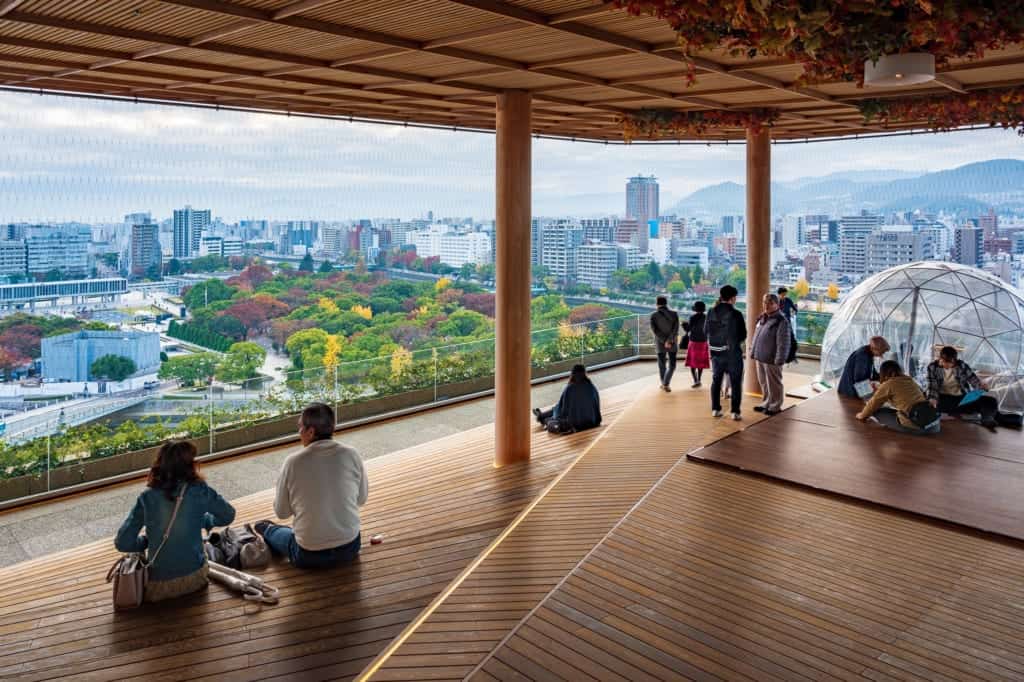
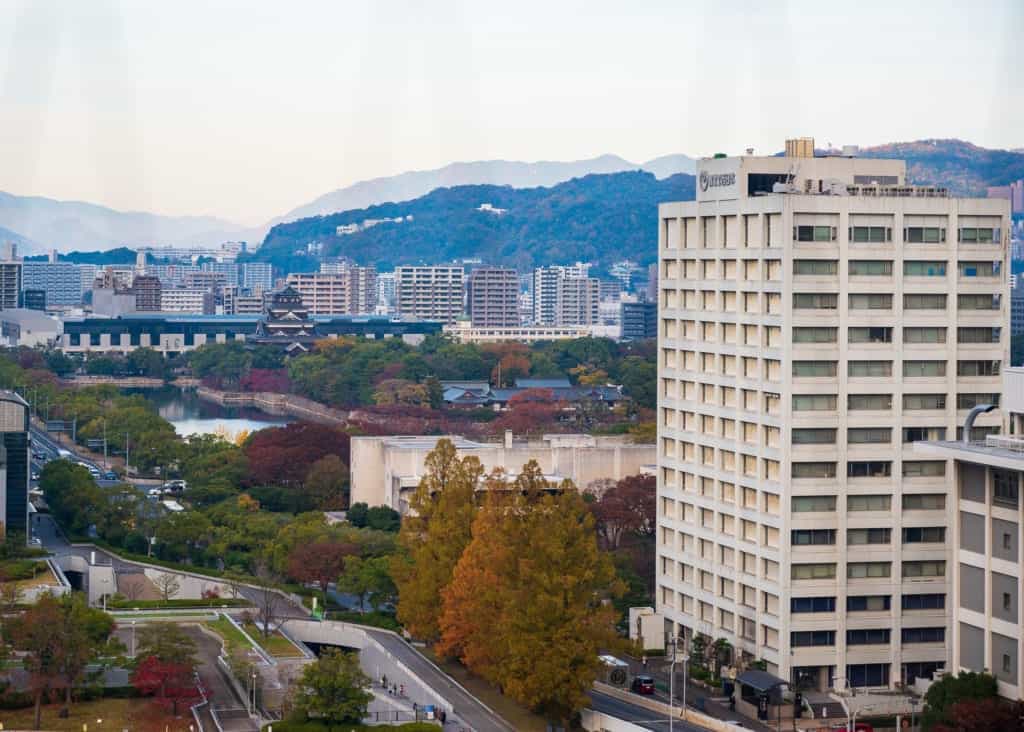
Also, until March 1st, 2020, the Hana Lumine event creates an even more extraordinary atmosphere on the observation deck. Plastic domes are set up where groups of friends can sit around a small table, enjoying the view, the company, and the warmth of being pseudo-indoors through the chilly winter.
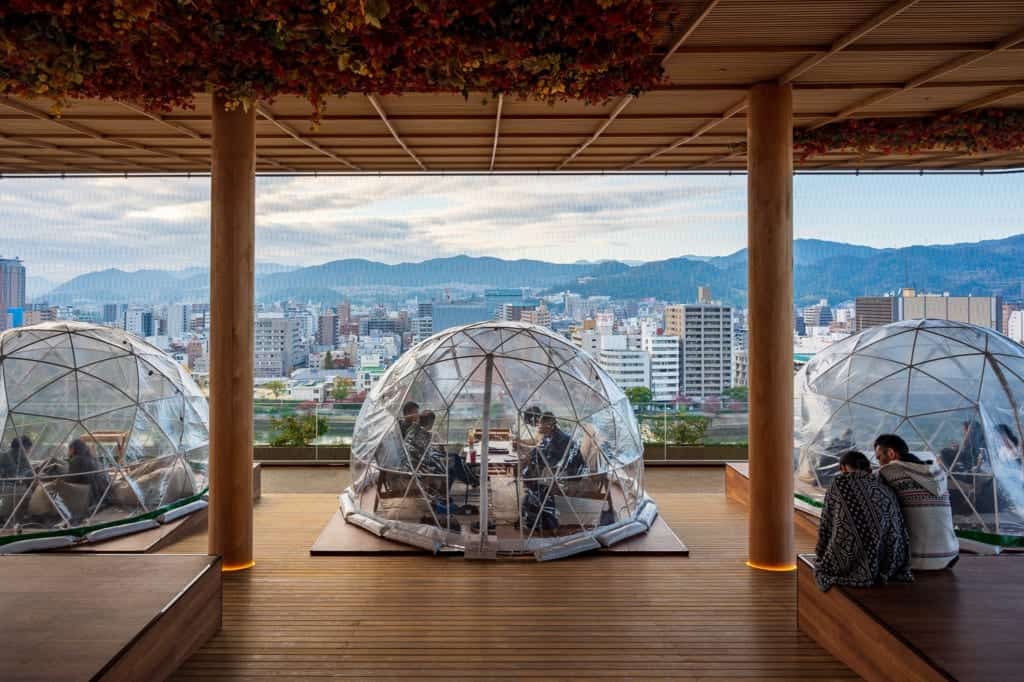
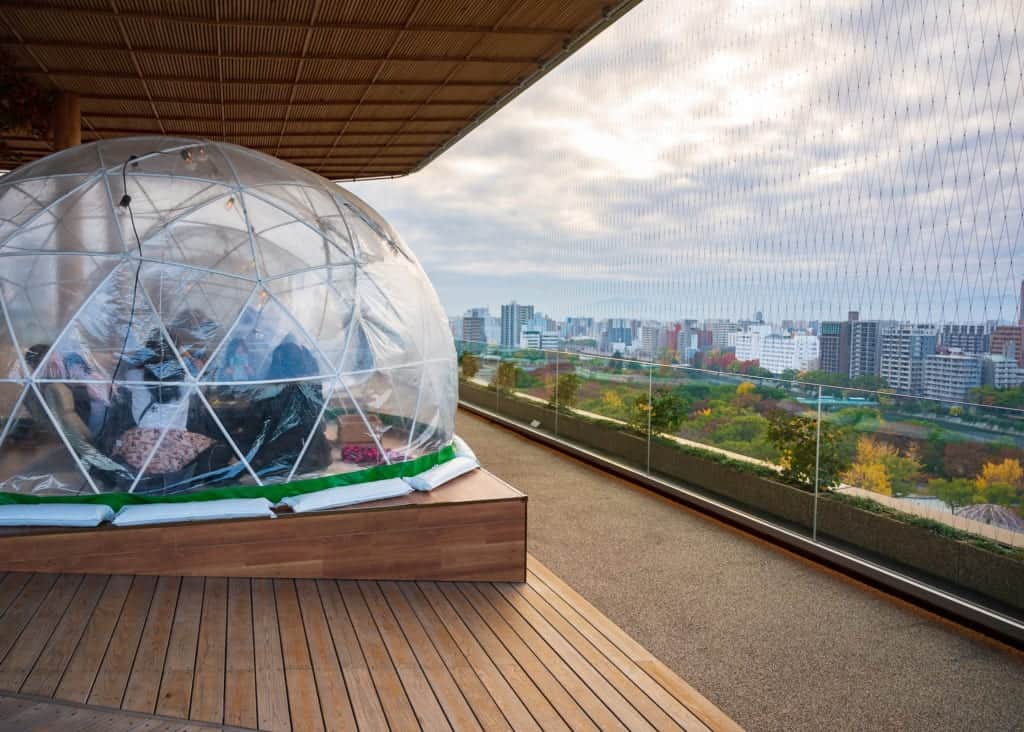
One floor below is Orizuru Square, a sizable indoor space that is rentable for events. When it is not being rented, you can interact with a few multimedia displays, or for 100 yen, fold a paper crane and add it to the Orizuru Wall, a glass partition in the front of the building which will eventually be filled with cranes made by visitors from around the world. Adding your crane to the wall requires you to walk out over a glass floor, 12 stories above the street, and drop your crane through a small opening. Some of you are thinking, “What fun!” For me? Absolutely terrifying.
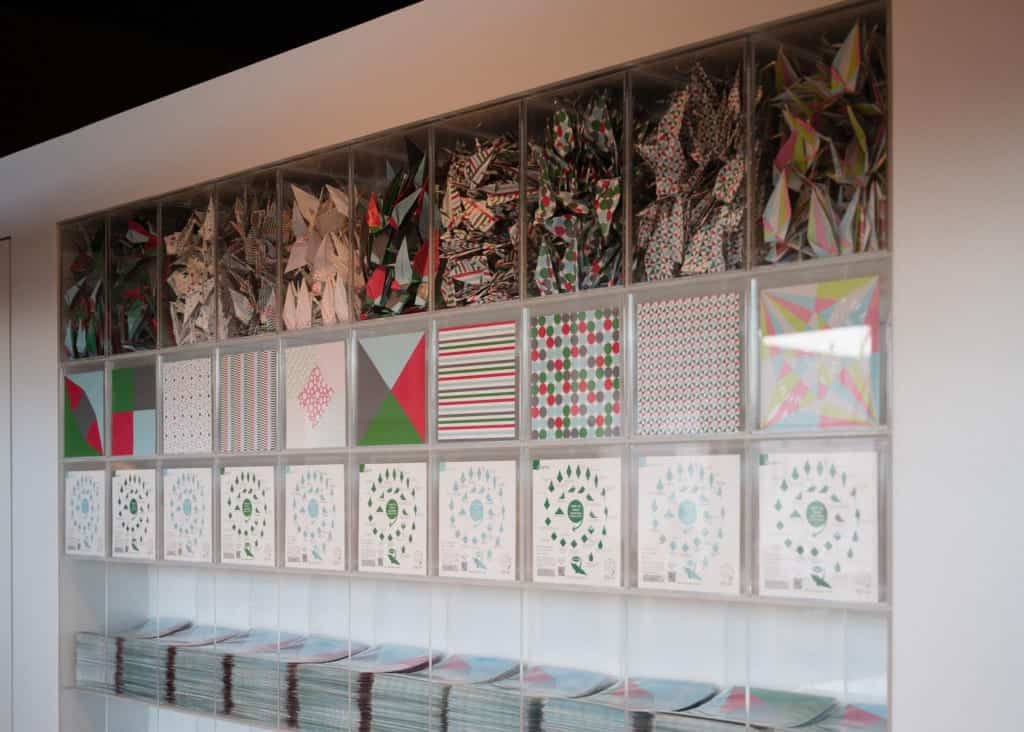
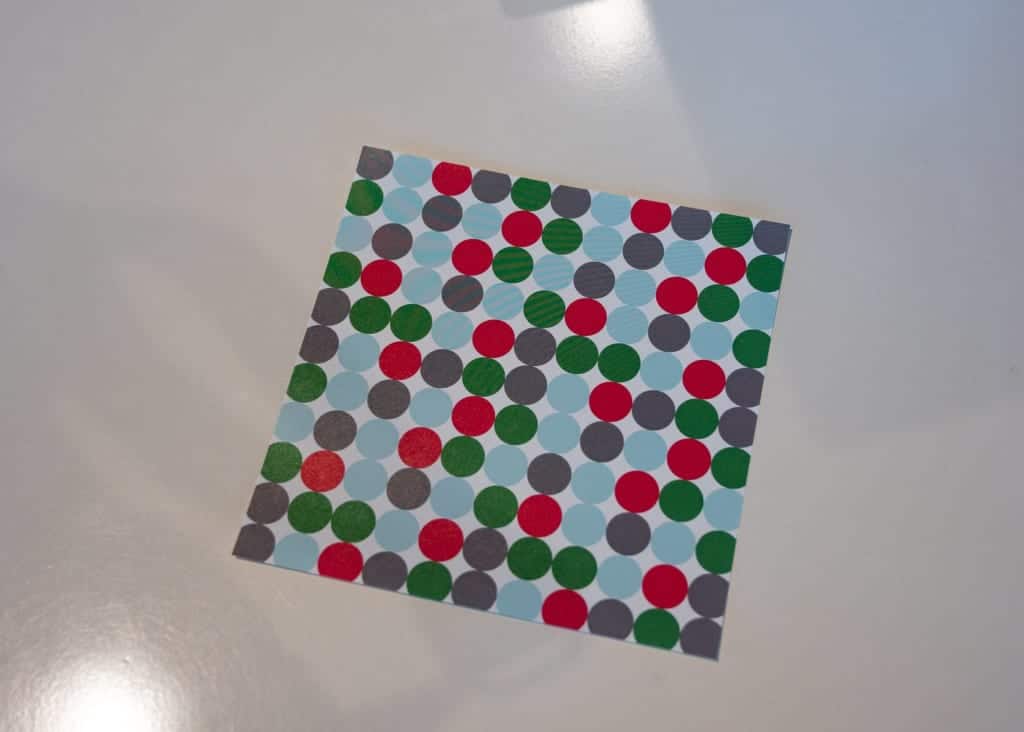
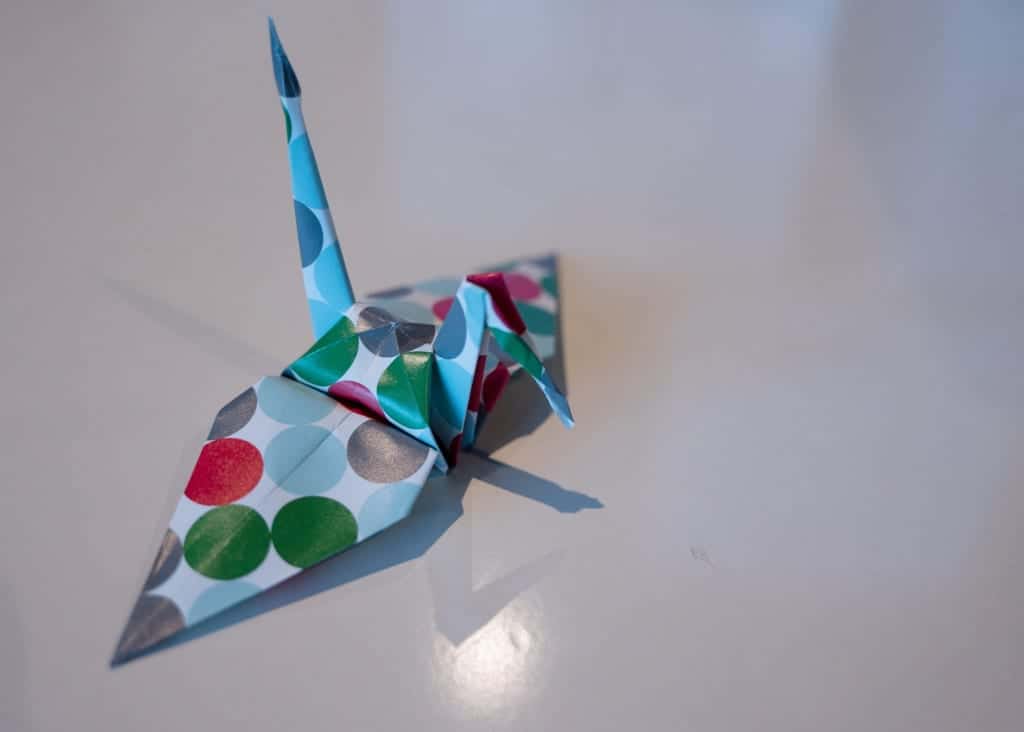
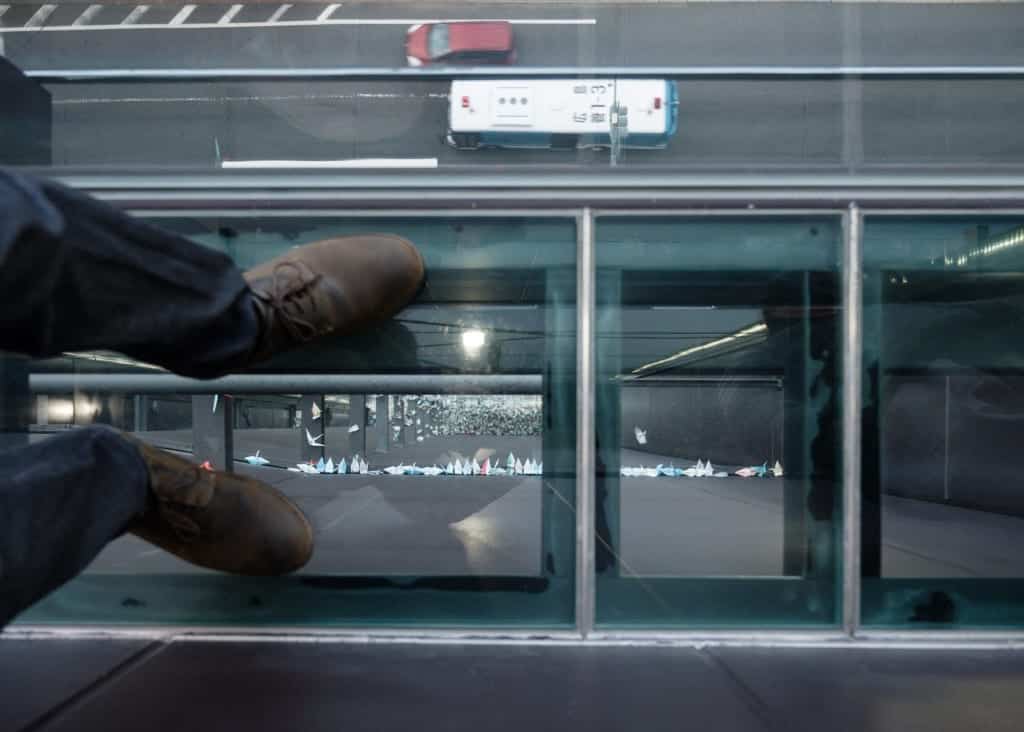
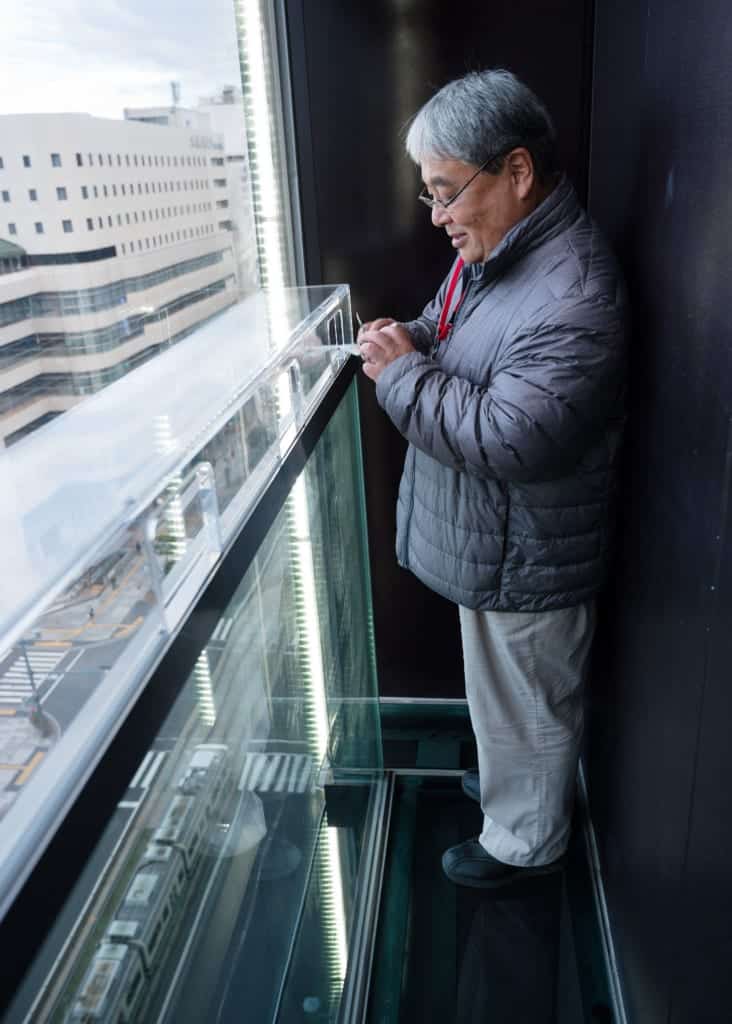
Even the descent back to the first floor of Orizuru Tower is an experience. The “Sampo” Spiral Slope is a barrier-free walkway from the observation deck to the first floor. You have three choices here: a gentle slope, a standard set of stairs, or for the young or young-at-heart, a spiral slide! You can exit the slide at any floor if you tire of it, or keep going all the way down. Guess what Sugano-san did.
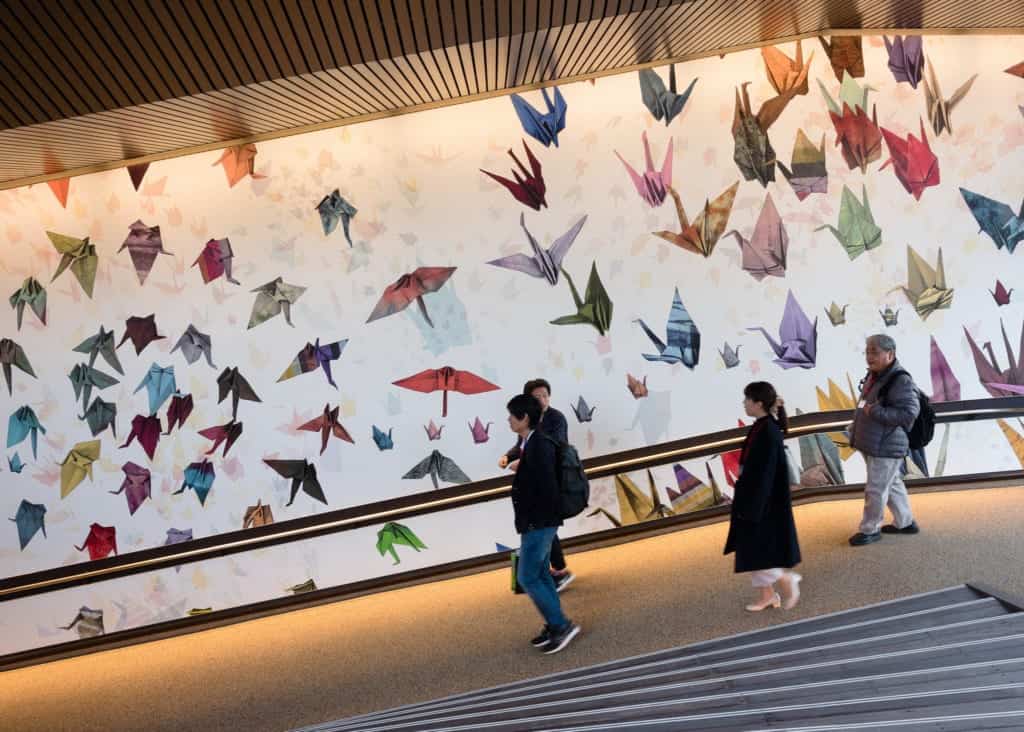
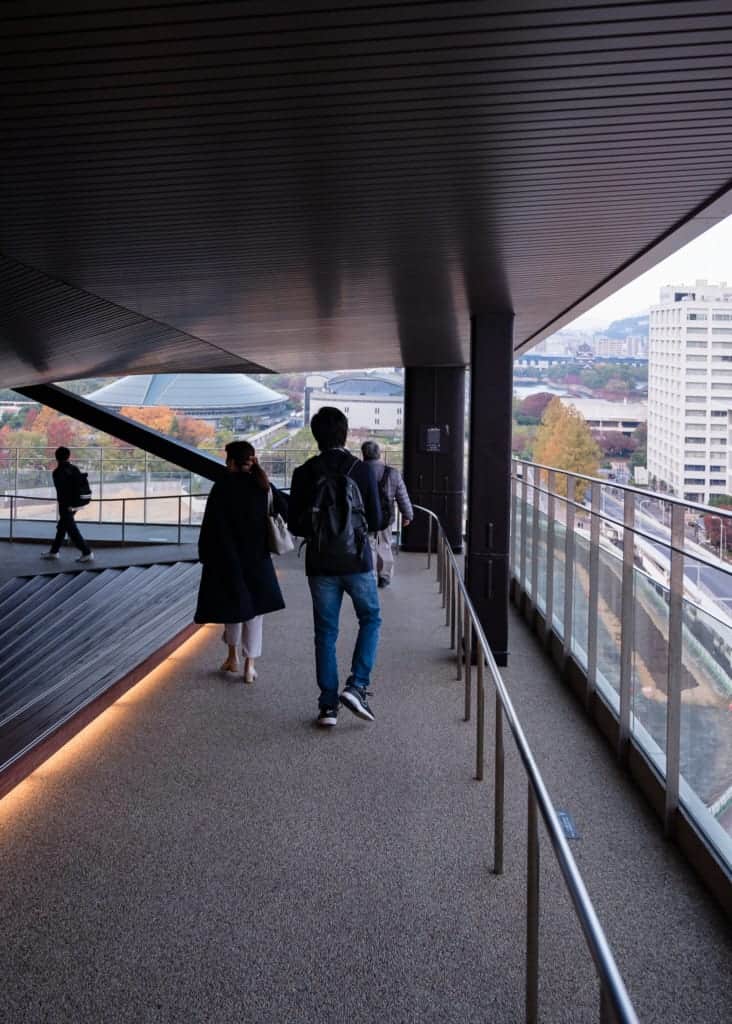
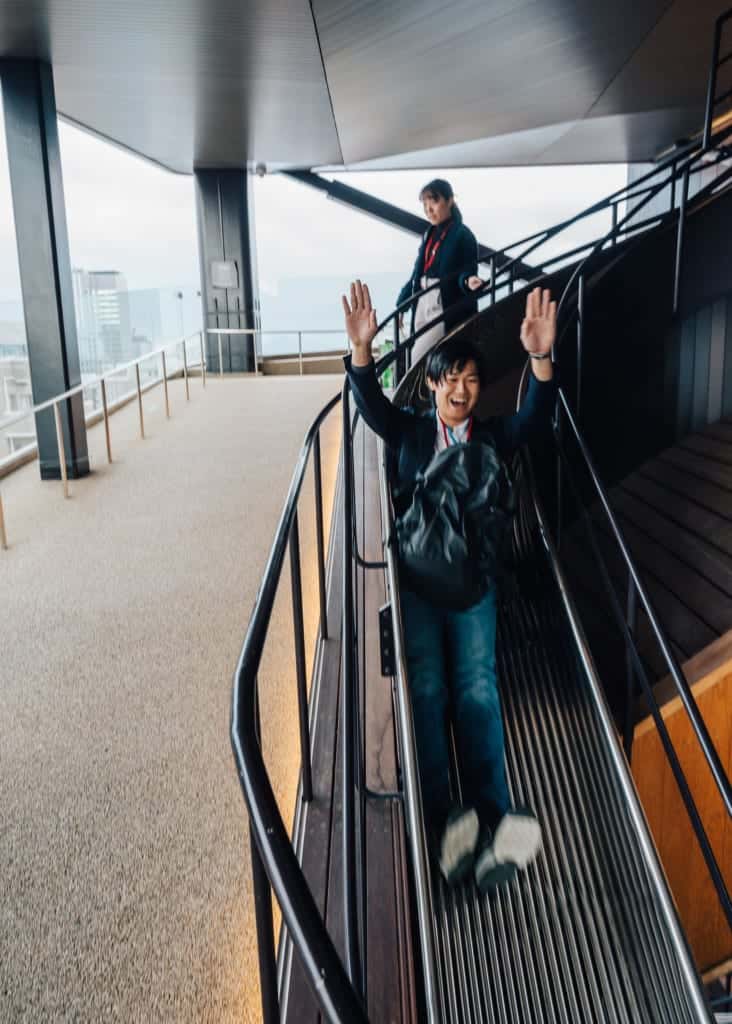
The first floor has a lovely souvenir shop featuring many of Hiroshima’s local specialties. I also met Heartonton, a dove mascot who surprised us all when he spoke to us. He was a bit smart with me; I think mascots should be seen and not heard.
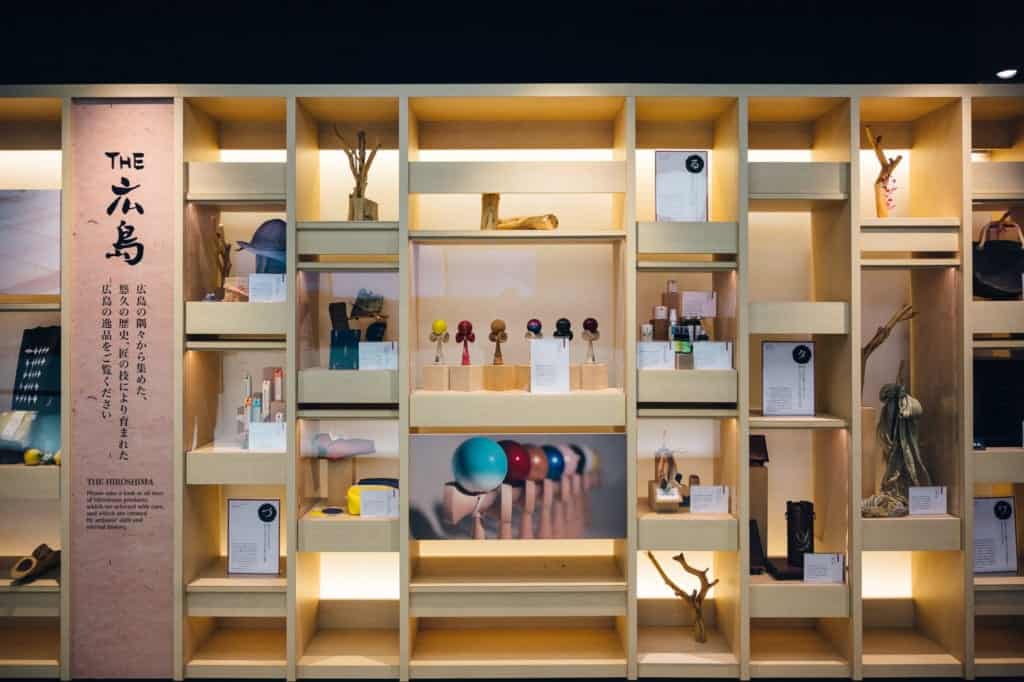
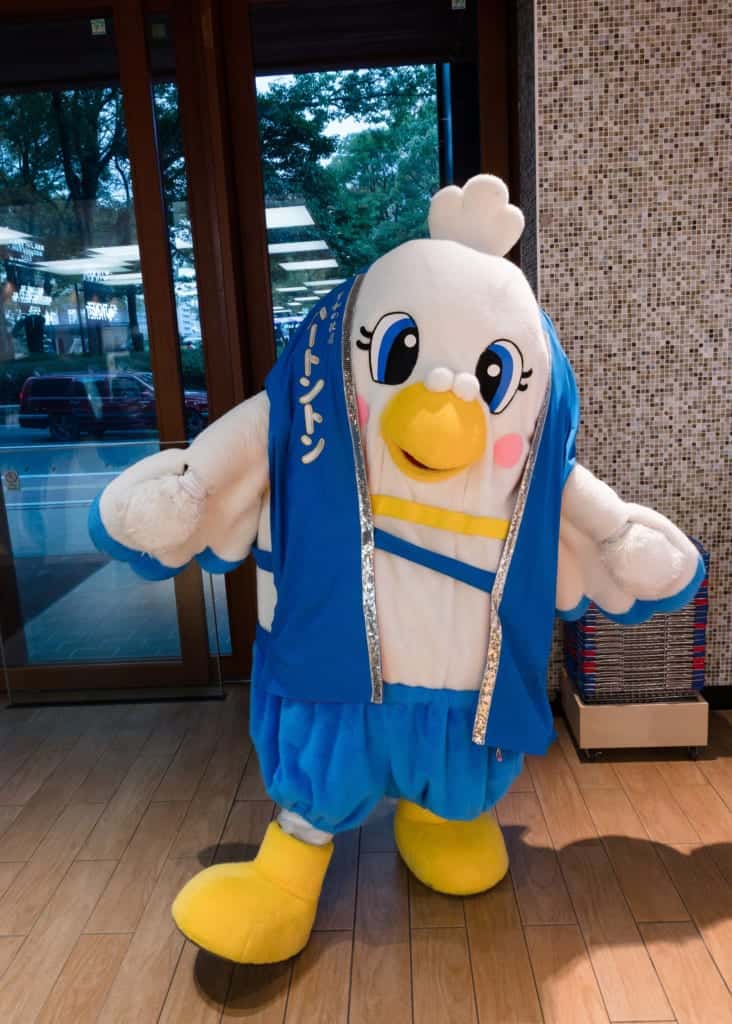
There is an admission fee to reach the upper floors of Orizuru Tower, but show your foreign passport for a nice sized discount.
Shukkeien: Light Up the Night with Autumn Colors
We still had a little time before the Peace Park reopened to the public. Fortunately, I had arrived in Hiroshima during the peak season for kouyou, the turning of the autumn leaves. Historic Shukkeien garden was a brief streetcar ride plus a few minutes walk away, and was famous for its illumination of autumn foliage. Using my Visit Hiroshima Tourist Pass, I rode the streetcar fare-free, and we alighted at Ebisucho, walking about 10 minutes from there to Shukkeien.
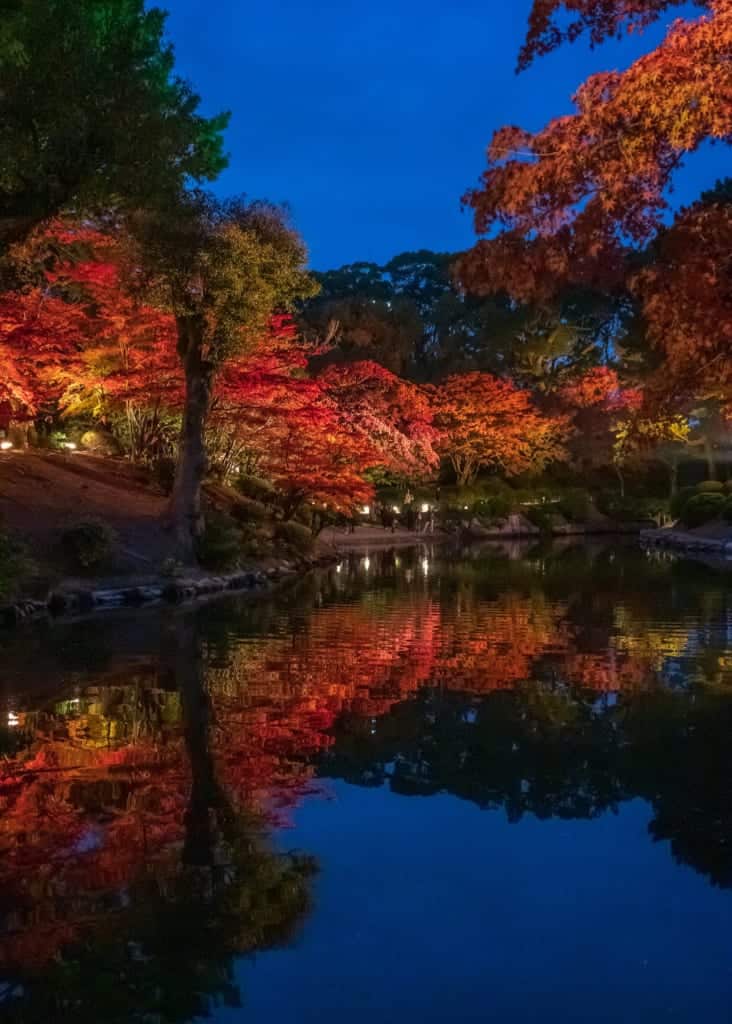
Though established by Hiroshima’s first daimyo lord in 1620, Shukkeien was close to the hypocenter of the atomic bomb and was thoroughly ravaged by the explosion and resulting fires. Only one tree in the garden remains from the pre-bomb days, carefully tended as a reminder of the city’s tragic history. It took nearly 30 years to restore the garden to its former glory, but today, it is a radiant beauty once again.
It is possibly never as beautiful as it is tonight, the bright red leaves of the Japanese maple illuminated by strategically placed spotlights. A small crowd of visitors, locals, and tourists gather on an island to get an Instagrammable shot of the maples reflected on the pond. It’s the best view of the garden, Eriko-san, a bus company employee who once worked at the garden, tells us. I would agree, minus the smartphone the tourist next to me kept sticking in front of my camera lens.
 Shukkeien Garden
Shukkeien Garden
TOURIST ATTRACTION- 2-11 Kaminoboricho, Naka Ward, Hiroshima, 730-0014, Japan
- ★★★★☆
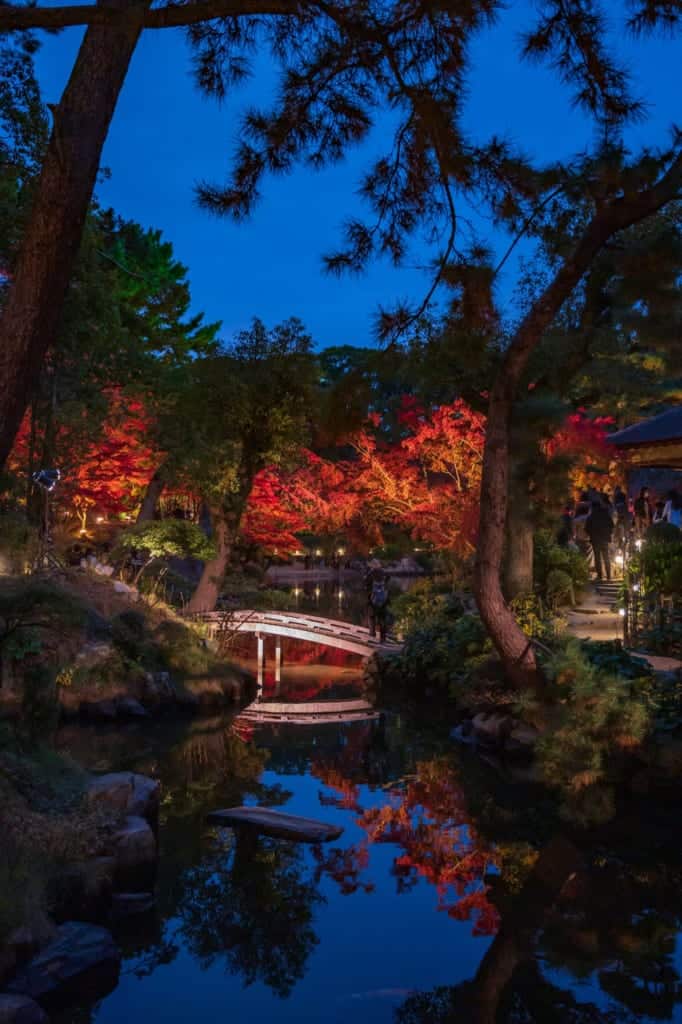
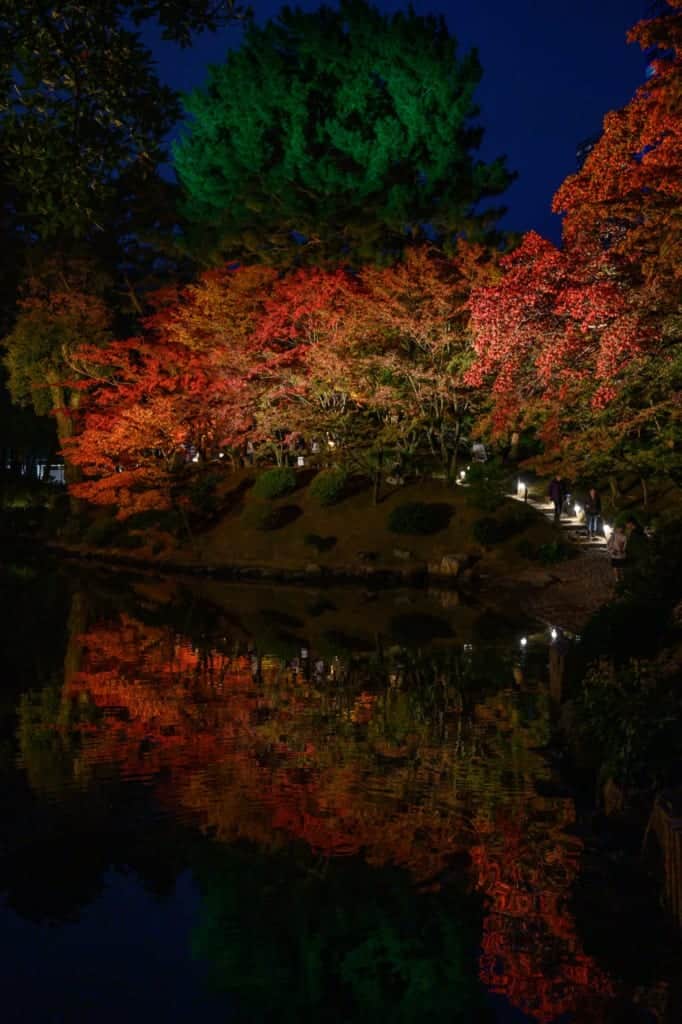
Hiroshima Peace Memorial Museum
Finally, around 8:00 pm, the Peace Park reopened to the public. Apart from the people being interviewed by local news programs and a couple of thousand empty folding chairs that were efficiently being removed, you would never have known the Pope had been there less than an hour earlier.
Sugano-san went with me to the Peace Memorial Museum, but once inside, he proposed that we browse the museum separately. As it turns out, Sugano-san is wiser than his youthful appearance would suggest. This museum demands that you take it in at your own pace, and not someone else’s. There are sections of the museum that you can’t drag yourself away from and others that you can’t escape from quickly enough. A panoramic view of the ruins taken from Ground Zero shortly after the attack. The torn and bloody remains of children’s clothing, many of whom suffered greatly before succumbing to death. I began taking photos of the early exhibits, but it was not long before the click of my camera shutter started to sound intrusive, and I put it away.
No travel article can convey the emotions of this sacred place. There were moments when I was close to tears; I felt I could not bear to look at one more remnant of the destruction or read another word about the suffering. Outside the exhibit room, people sat in silence, staring at the floor, trying to regain their composure. I was not the only one feeling the frailty of my humanity that day.
I walked briskly back to my hotel in solitude, trying not to think too hard about what I had just seen. I had an early day tomorrow and did not want to lie awake in my bed all night, trying to make sense of it all. I paused for a moment on the bridge over the Motoyasu River, where on the bank nearby, the skeletal remains of the Atomic Bomb Dome stood defiantly. Suddenly, a glimmer of hope shone in the darkness. Hiroshima did not die on that day in August 1945; it was reborn as the City of Peace.
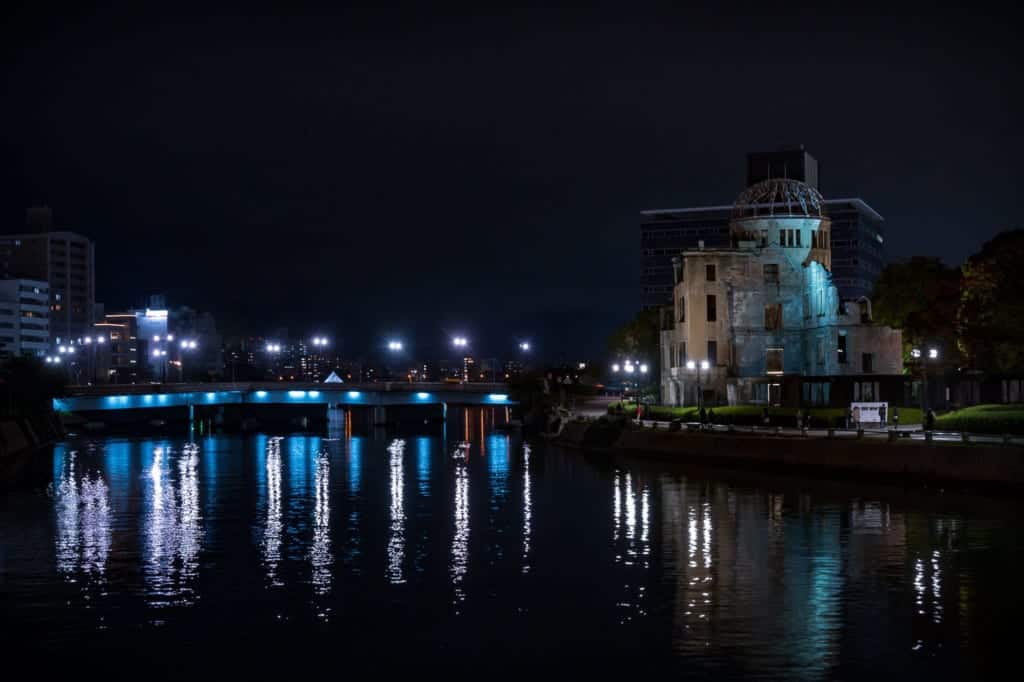
More about Staying in Hiroshima
I stayed at the RIHGA Royal Hotel, a few minutes’ walk to the Peace Park, and next door to the Hiroshima Bus Terminal. It made perfect sense for me to stay here because we’d be using the Bus Terminal often over the next six days, but there is a growing list of comfortable and convenient hotels in the area around both the Bus Terminal and the JR station.
One of the things I wish I had time for was Hiroshima Kagura performance, which takes place on Wednesday evenings from April 3rd to December 25th at the Hiroshima Prefectural Citizen’s Cultural Center. Kagura is a live performance that is something like kabuki, with beautiful dances and extravagant costumes. There are 2 different performances each Wednesday, and you can see both for just 1,200 yen. Hiroshima Prefecture has a rich kagura heritage, which is actively being taught to younger generations so it will continue to thrive here. Learn more about attending a Hiroshima Kagura performance on their English website.
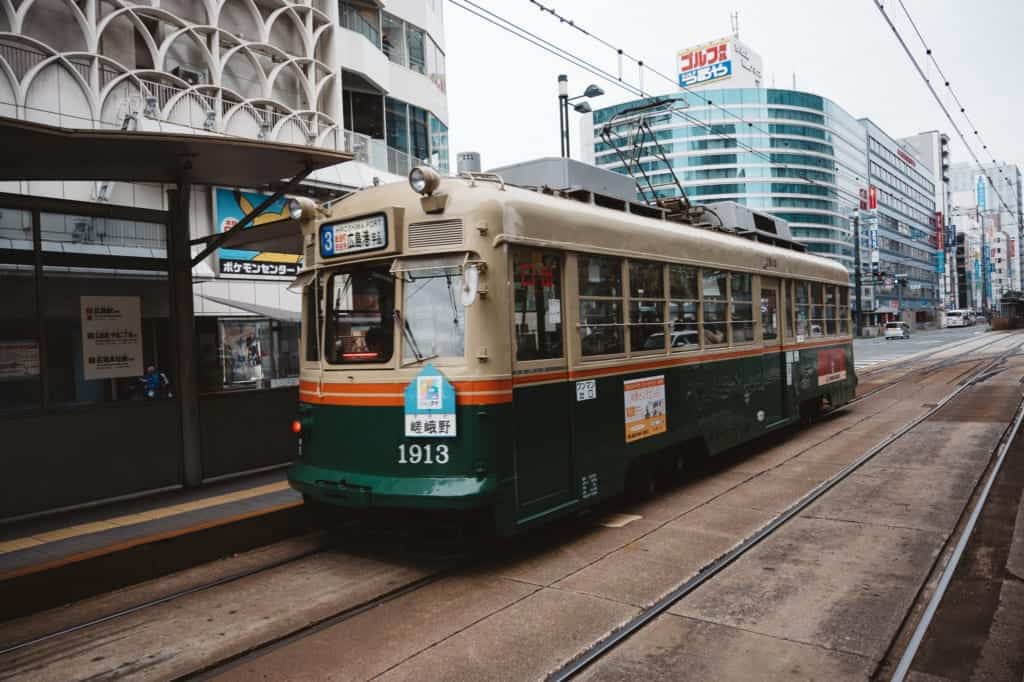
Getting around Hiroshima is easiest by streetcar, and the fare is covered by the Visit Hiroshima Tourist Pass, though if you only plan to stay in Hiroshima city, it would probably be cheaper to pay the streetcar fare. If you plan on taking a couple of excursions outside the city by bus, the pass will likely pay for itself easily. If you enjoy getting some exercise, Peacecle is an electric bicycle sharing service with a daily flat rate and many locations throughout the city. Register online and download the app, and you’re ready to go!
For other ideas about spending more than a day in Hiroshima and the surrounding area, check out the Visit Hiroshima & Beyond website.
Tomorrow, I will be up bright and early to catch a bus to nearby Miyoshi city, where a brand new, first of its kind museum awaits us!
Sponsored by Chugoku Region Tourism Promotion Association / Chugoku District Transport Bureau
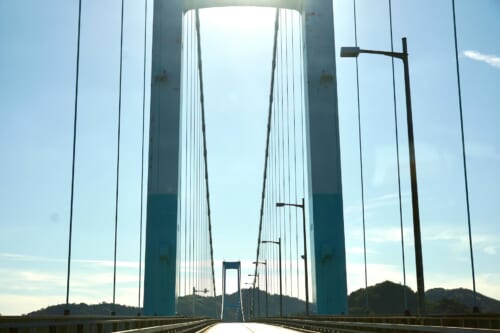
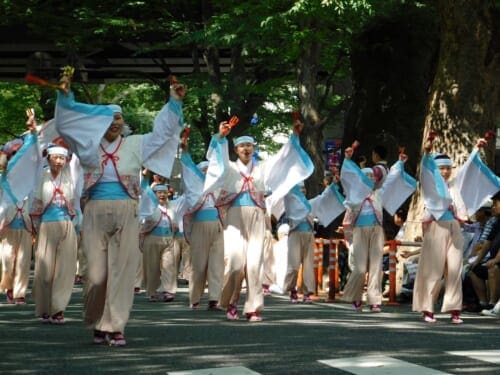

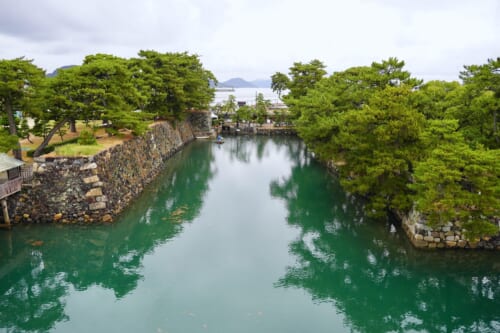
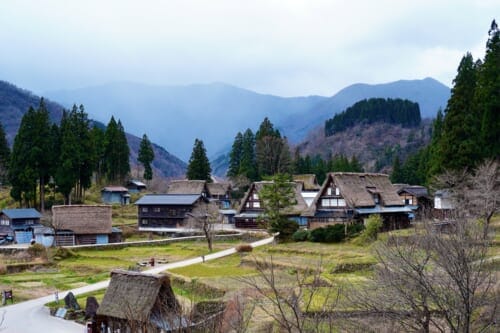
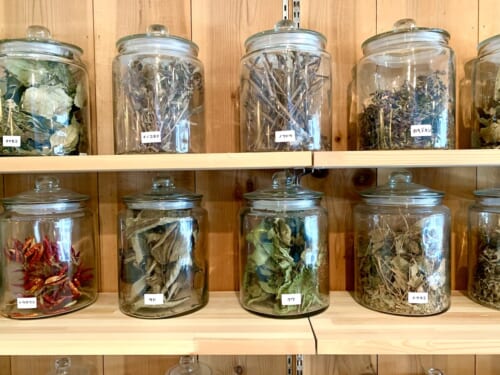
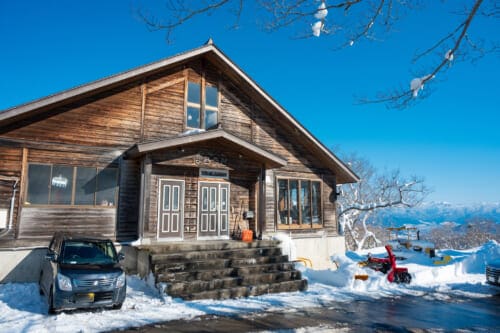
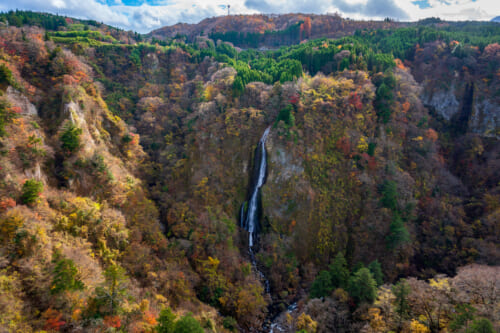
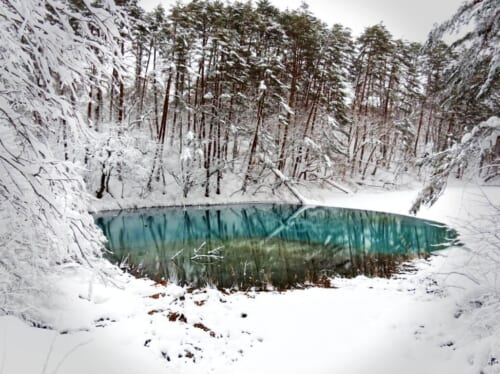
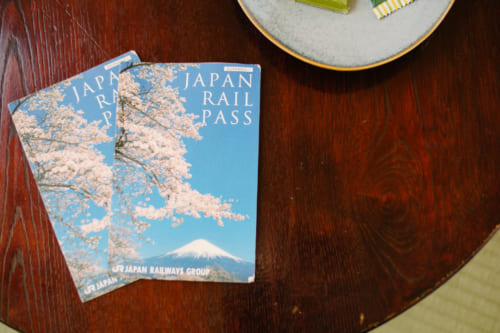
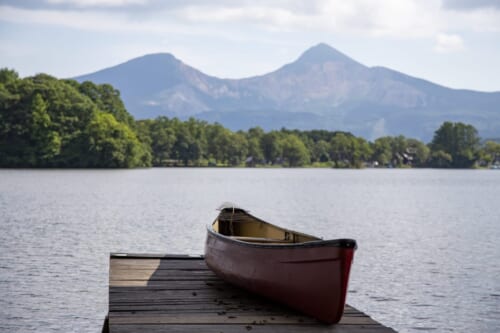


No Comments yet!